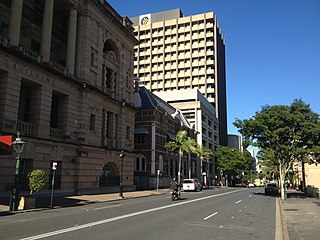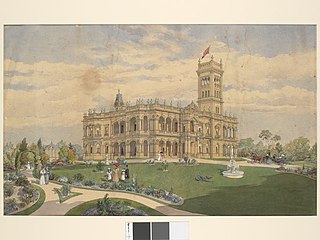
Queensland's first Government House is located at Gardens Point in the grounds of the Queensland University of Technology at the end of George Street in Brisbane, Queensland, Australia. The building's construction was the first important architectural work undertaken by the newly formed Government of Queensland. It is listed on the Queensland Heritage Register.

Rocklea is a southern suburb in the City of Brisbane, Queensland, Australia. In the 2021 census, Rocklea had a population of 1,672 people.

Brisbane City is the central suburb and central business district of Brisbane, the state capital of Queensland, Australia. It is also colloquially referred to as the "Brisbane CBD", "the city", or simply "town". The CBD is located on a point on the northern bank of the Brisbane River, historically known as Meanjin, Mianjin or Meeanjin in the local Yuggera dialect. The triangular-shaped peninsula is bounded by the median of the Brisbane River to the east, south and west. The point, known at its tip as Gardens Point, slopes upward to the north-west where the city is bounded by parkland and the inner city suburb of Spring Hill to the north. The CBD is bounded to the north-east by the suburb of Fortitude Valley. To the west the CBD is bounded by Milton, Petrie Terrace, and Kelvin Grove.

Petrie Terrace is an inner suburb in the City of Brisbane, Queensland, Australia. In the 2021 census, Petrie Terrace had a population of 1,168 people.

George Street is a major street located in the Brisbane CBD in Brisbane, Queensland, Australia.

William Street is a small, relatively quiet road in the uptown part of the Brisbane central business district. The street is historically significant to the city's early development as a penal colony. The first convict buildings were built along William Street in 1825.

George Edmondstone (1809–1883) was politician in Queensland, Australia. He was a Member of the Queensland Legislative Assembly and an alderman and mayor in the Brisbane Municipal Council.

Diamantina, Lady Bowen, was a noble from the formerly Venetian Ionian Islands who became the wife of Sir George Bowen, the first Governor of Queensland.
Charles Tiffin (1833–1873) was an English architect, who spent most of his career in Queensland, Australia where he held the post of Queensland Colonial Architect.

Hon. Patrick Perkins, J. P.,, nicknamed Paddy Perkins, was a brewer and politician in colonial Queensland. He was a Member of the Queensland Legislative Assembly and, later, a Member of the Queensland Legislative Council.

Lady Bowen Hospital is a heritage-listed former maternity hospital and now social housing and office complex at 497–535 Wickham Terrace, Spring Hill, City of Brisbane, Queensland, Australia. It was designed by John H. Buckeridge and built from 1889 to 1890 by John Quinn. It was also known as Brisbane Lying-In Hospital and the Lady Bowen Hostel. It was added to the Queensland Heritage Register on 23 April 1999. The complex consists of the former hospital and nurses' quarters buildings; a third building which had been contained in the heritage listing was demolished c. 2005–2008.

George Harris (1831–1891) was a politician in Queensland, Australia. He was a Member of the Queensland Legislative Council.

George Carter (1864–1932) was a politician in Queensland, Australia. He was a Member of the Queensland Legislative Assembly.

The Great fire of Brisbane was a major conflagration that swept through the central parts of Brisbane in the Colony of Queensland on 1 December 1864. For two and a half hours the fire burned out of control in large parts of Brisbane's central business district with entire blocks being destroyed, mainly in Queen, Albert, George, and Elizabeth Streets. It consumed 50 houses, 2 banks, 3 hotels, 4 draperies, and many other businesses as well as a "considerable amount of small houses". Considering the extent of the fire, casualties were very few; there was no loss of life, and four people were taken to hospital with injuries.
Teneriffe House is a heritage-listed villa at 37 Teneriffe Drive, Teneriffe, City of Brisbane, Queensland, Australia. It was designed by William Henry Ellerker and built in 1865. It was added to the Queensland Heritage Register on 14 May 1993.

Killarney is a heritage-listed detached house at 9 Laurel Street, Enoggera, City of Brisbane, Queensland, Australia. It was built c. 1860s. It was added to the Queensland Heritage Register on 21 October 1992.

Harris Terrace is a heritage-listed terrace house at 68 George Street, Brisbane City, City of Brisbane, Queensland, Australia. It was designed by J & G Cowlishaw and built from c. 1866 to c. 1867 by Mr Clarke. It is also known as Harris Court. It was added to the Queensland Heritage Register on 21 October 1992.
Thomas Symes Warry was a pioneer chemist and politician in Queensland, Australia. He was a Member of the Queensland Legislative Assembly.

The Canberra Hotel was a temperance hotel on the western corner of Ann and Edward Streets, Brisbane, Queensland, Australia.

William Henry Ellerker (1837-1891) was an architect and politician in Melbourne, Victoria, Australia. He was Mayor of St Kilda.


























